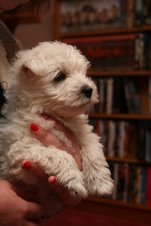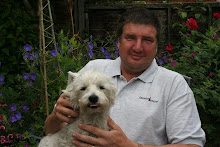Our gander has a condition known as "wry-tail". If you look at the right hand yellow circle in this picture you will see his tail is swung round to 45 degrees or so to his left; this is not because I have caught him wagging it, as they do, but this is its resting position. This is a common, known condition in all sorts of domestic poultry; it does not hurt and they do not suffer in any way, they develop normally other than the tail and their fertility is not affected. It is genetic, though 'recessive' and so can be passed on to offspring. What happens is that the pelvis, which should be fairly long and narrow, and aligned north-south (as anyone who has carved a chicken will know) develops bent round to around 45 degrees behind the hip joints, either left or right. Aft of the pelvis all the tail bones and muscles are normal, so that the goose has normal mobility of the tail, feathering and so on but starting from a resting position at a jaunty angle.
Now that the goslings are starting to sprout true feathers through their fluff, including tail feathers, we have noticed that 4 of the 5 of them also have left handed wry-tail. Normally you are advised not to breed from a wry tail bird but as he's all we've got and we are breeding only to eat them ourselves, we are taking that with a pinch of salt. I assume it is a rare condition in wild geese because it must seriously impair flying but in the domestic flock nobody is flying very far and the main selection process is not 'survival of the fittest' but the farmer saying 'will I breed from that bird or not?' Thinking it through, it did occur to us that if this is a recessive condition, then one or both female geese must be heterozygous for wry-tail (half wry-tail or 'carriers' if you like) so we were left wondering whether these geese and the gander may actually be siblings rather than a true breeding group as advertised. Once again, though, we think that as we are only breeding internally, and the goslings we have do not seem to be too in-bred, we will carry on.
This week, in the fierce heat of our hot-spell, we have given up on demolishing the earth/rubbish bank and moved in under the trees of the bit we call 'the woods'. This area was beautifully grazed short by the sheep till spring but has since gone a bit mad with nettles, ground elder, hog-weed and goose-grass (cleavers). We decided to have at it with the sickle and cart away the green tops in wheel barrows. Not only would this tidy the area up but we also might find the stashes of eggs we believe our badly behaved Sussex Ponte hens are hiding in there.
The first half of this plan is working well and we feel as if we are getting a whole chunk of garden back but on the latter we are less successful; having only found one stash of 7 eggs so far. In case there is a problem with the age of these eggs we crack them carefully into a separate bowl before using them in any cooking but so far we have never had an off one. From being a bit short of eggs we suddenly have over a dozen on stock.
Even better, one of the hens has come back into 'the fold' as it were, having discovered my stack of new home-made hay in the goose-barn. I have been leaving the door wedged open to let some air through so that Broody Betty would not overheat and the hen, finding the hay, discovered that she could creep in round a feed dustbin and make a little nest out of sight at the bottom of the hay. One of the Marans followed her in today, seemingly led there by the rooster and added this nice speckled one. We are allowing this as at least we know where to find the eggs.
Sunday, 14 July 2013
Ahhhh Look! He has his Father's... Tail!
Labels:
Broody Betty,
carriers,
genetic,
ground elder,
heterozygous,
hog weed,
nettles,
pelvis,
Wry-tail
Subscribe to:
Post Comments (Atom)






No comments:
Post a Comment